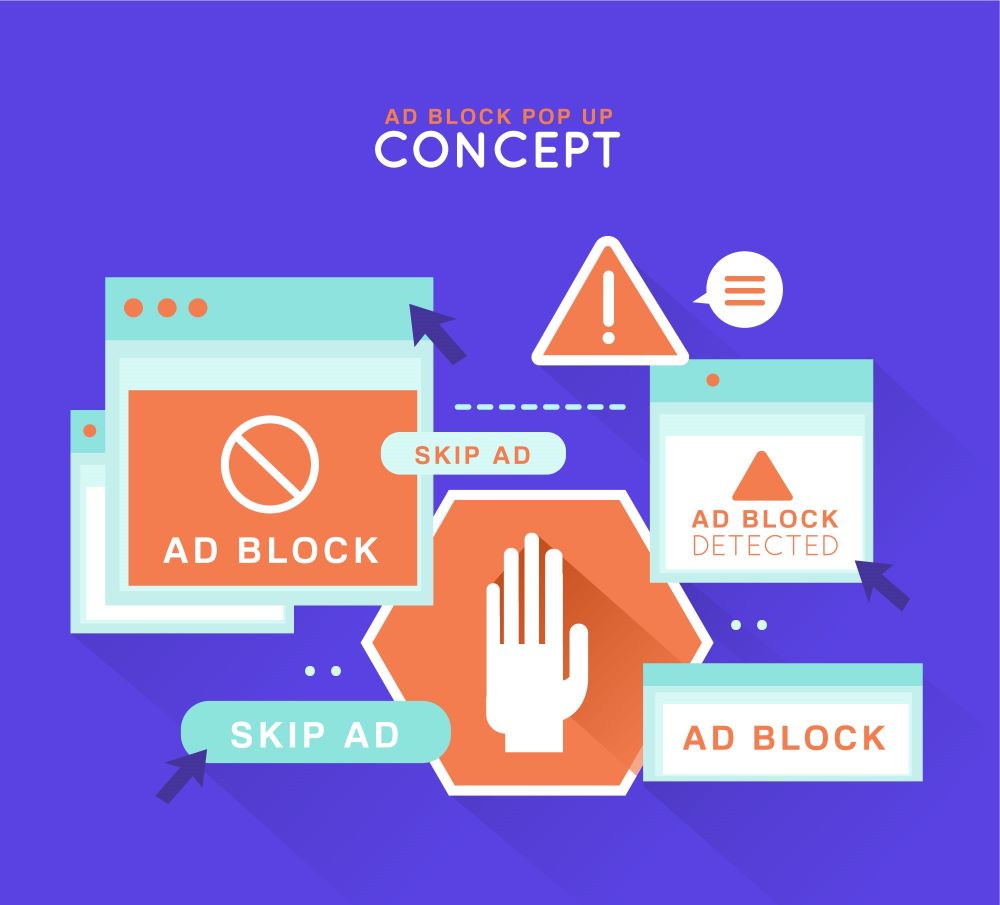According to the Association of National Advertisers, the cost of digital ad fraud is approximately $120 billion annually. Another report states that ad fraud takes $1 for every $3 spent on digital ads, significantly hurting the effectiveness of PPC campaigns and draining ad budgets.
What Is Ad Fraud?
The term ad fraud refers to the practice of manipulating and falsifying the number of times an online advertisement is clicked on or shown to users. It involves cheating advertising networks to deceive advertisers into paying them.
The advertising platforms mistakenly assume that the activity on their network comes from real users. However, in reality, the activity is fake, and the impressions, clicks, and conversion data are simply inflated.
Given the large variety of means and methods available to scammers, ad fraud can be divided into distinct categories.
Types of Ad Fraud
Ad fraud can take the form of bots pretending to be humans, inflating impressions through bogus engagement, using click farms, and so forth. Below are some common types of ad fraud.
Click Fraud/ Bot Fraud
Click fraud refers to any form of fake click on online content. It usually affects online ads, polluting analytics without giving any positive results such as new purchases or leads.
Click fraud aims to drain the competitor’s advertising budget prematurely by making their ad disappear from the search results earlier than necessary. As a result, the competitor’s advertising investment might partially or completely go to waste and not provide the intended online visibility and ROI.
Click Spamming/Click Flooding
During click spamming, networks experience an extensively high number of unreal clicks. The objective is to take credit for the conversion, thereby fooling advertisers into paying for the fake clicks.
Some common signs of click spamming include lower conversion rates and reduced sales from your ads. Moreover, if you notice an unusually big difference in the frequency of clicks or a remarkably faster draining of your Google Ads budget, that’s another clear sign of click flooding.
Impression Fraud/Display Fraud
During impression fraud, criminals create the appearance that an ad got a view, even if it really didn’t. Impression fraud can be particularly concerning for advertisers that run ads on CPM payment models. CPM (cost per mile) is the average price an advertiser pays for every 1000 impressions. Thus, if some or all of the 1000 impressions are fake, then the advertiser ends up paying for non-existent views.
Pixel Stuffing
Pixel stuffing refers to the deceptive practice of embedding a normal-looking ad with a fraudulent pixel that is “stuffed” with multiple hidden ads. The pixel is so small that it’s invisible to the human eye, making it appear that the ads are being viewed by real users, whereas in reality, no one can see them.
Ad Stacking
In ad stacking, multiple ads are ‘stacked’ (i.e. layered) on top of each other in one single ad placement. Only the top ad is visible, but a click or impression is registered for every ad in the stack, leading to misleading and fake impressions.

Domain Spoofing
Domain spoofing refers to the practice of impersonating a legitimate company’s website name or email domain. Attackers do this to act as a legitimate entity and get people to trust them. As a result, users might share otherwise protected information with hackers and fall victim to security breaches and data leaks.
Forced Redirect Ads
In the case of forced redirect ads, users opening a webpage of their choice unwillingly get redirected to some other web page. Then, the users might be shown fraudulent ads or get their systems infected with malware. As the code is hidden in the ad pixels, scammers can still achieve what they want even if the users don’t directly click on the link.
SDK Spoofing
During SDK Spoofing, or “Replay Attacks,” hackers use third-party SDKs to create fake user engagement signals. This method simulates ad clicks, app installs, and in-app actions. Businesses that trust these fake engagement signals might therefore make wrong marketing decisions and experience significant financial loss.
Ad Injection
Ad injection is the practice of unlawfully inserting ads in apps and web pages without paying the app or website owner or getting permission from them. If inappropriate ads appear on your site, they can significantly damage your business’s reputation and drive visitors away. Inappropriate ads may include malware, adult content, betting services, get-rich-quick schemes, and so forth. These mismatched and unpleasant ads may offend or misguide your audience, leading to a loss of trust, customers, and revenues.
Geo Masking/Location Fraud
Manipulating geographic locations is a common practice used by hackers to undermine your business’s online advertising efforts, while also making it harder for you to trace these fraudsters.
For instance, if an advertiser aims to target Rome, hackers in other parts of the world might geo-mask and make it seem like they’re based in Rome when viewing and engaging with the ad. As a result, the advertiser might end up paying for engagement from the wrong geographical area.

Who Is at Risk of Ad Fraud?
Ad fraud can negatively impact digital marketing agencies, sales teams, publishers and ad networks, advertising platforms, brands, and even ordinary users. Of course, advertisers suffer the most, often experiencing financial losses of thousands to millions of dollars, risking their brand image and reputation.
Impact of Ad Fraud on Brands
Ad fraud can significantly reduce the return on ad spend (ROAS), while also leading to higher customer acquisition costs (CAC). Additionally, fraudulent traffic and fake leads can severely impact a brand’s reputation and thereby push away existing or potential customers.
Ad fraud also distorts the data that sales teams use to make decisions. For example, they get fake phone numbers or fake lead data (stolen personal details, possibly of people who are not interested in the given product or service).
How Ad Fraud Threatens Brand Safety
Along with leading to inflated ad impressions and wasted spending, ad fraud can also compromise your brand’s safety. Fraudulent clicks can result in your ads being shown on harmful, inappropriate websites that feature offensive content, hate speech, or fake news. Being presented on such platforms may severely damage your brand reputation and create an image of untrustworthiness around your business.
How Is Ad Fraud Detected?
Detecting ad fraud can be tricky considering the abundance of methods in the fraudsters’ arsenal. Oftentimes, a detection mechanism for one type of ad fraud may not be effective for another. Some companies specialize in ad fraud detection and use algorithms to identify fraudulent behavior. Potentially fraudulent behavior may include abnormally high click-through rates (CTRs) and poor or no campaign performance (such as getting 1000 clicks but no conversions).
Then, the ad-fraud detection companies can use this information to blacklist certain URLs and IP addresses that seem to be conducting fraudulent activities. For example, Google’s Ad Traffic Quality Team uses live reviewers, automatic filters, machine learning, and deep research to detect and filter invalid and fraudulent activity from malicious actors.
How to fight ad fraud
Ad fraud is such a channel that calls for proactive strategies in order to protect marketing investments. Companies should introduce advanced fraud detection tools analyzing real-time data, strict IP whitelisting, and blacklisting strategies to block or allow traffic coming from certain regions. They also need to collaborate with trusted ad networks that have strict verification procedures. It is equally important to train the marketing teams in detecting fraud, which may indicate a sudden drop in engagement or anomaly of traffic. Direct partnerships with reputable publishers or media outlets further help in keeping control of the ad placements and hence ensuring that the traffic is valid.

Key Safeguards Against Ad Fraud
Safeguards against ad fraud involve both preventative and reactive measures. It’s very important for early fraud detection to monitor performance metrics regularly and perform real-time analyses. Multi-layer verification, AI-powered tools, and the capability to flag networks tagged can help limit exposure to fraud. Brands also need to stay updated on emerging tactics, such as click farms and botnets, by continuously updating their anti-fraud systems.
Below are several safeguards that can potentially protect you and your business against ad fraud.
Investing In Ad Verification Tools
Investing in the right ad verification tools and services can help you show your ads only to real users and potential customers. Ad verification tools are rather at the core of the process of the detection and reduction of ad fraud.
Below are some examples of helpful ad verification tools:
- Adloox: A comprehensive, independent ad verification and insights platform that aims to enhance data transparency and allow businesses to improve their ad campaigns.
- CHEQ: Helps protect against bots and fraudsters by securing your data and on-site conversion.
- Pixalate: An omnichannel ad fraud protection, privacy, and compliance analytics solution for websites, mobile ads, and Connected TV.
In addition to protecting a brand’s marketing budget, investing in these tools will enhance the credibility and effectiveness of a brand’s campaigns.
Partnering With Trusted Ad Networks
Collaborate only with trusted and reputable advertising partners who have firm anti-fraud measures and mechanisms in place. Before you start collaboration, require information on documented fraud prevention strategies and tools the potential partner uses to protect your data.
Using Programmatic Advertising Carefully
Make sure to clearly define your goals, objectives, and intended target audience when setting up programmatic ads, and do the necessary research to choose the right type and channel for your ads.
Implementing Whitelist And Blacklist Strategies
Take note of the entities you trust and define prohibited entities that present some kind of harm to you and your business. Drawing clear boundaries between the two will help you immensely at the decision-making stage. This strategy gives businesses more control over ad placements, reducing the likelihood of falling victim to fraud. By continuously updating these lists based on traffic quality and campaign performance, businesses can protect their ad budgets from being wasted on fraudulent traffic.
Conclusion
Informed means armed. Enhancing online safety and maintaining a consistently positive brand image requires time, effort, and adherence to specific tactics, but the results are worth it. Ad fraud is an ongoing problem for digital marketing, but it is worth noting that it could easily be combated, provided that businesses employ the right strategies and tools. By investing in ad verification tools, partnering with trusted networks, cautiously deploying programmatic advertising, and using whitelist and blacklist strategies, marketers can reduce the severity of fraudulent activities. Marketers, on the other hand, need to remain vigilant in monitoring KPIs and refreshing fraud-detection systems in an ever-complex space to make sure ad budgets are well spent on targeting real and engaged audiences.